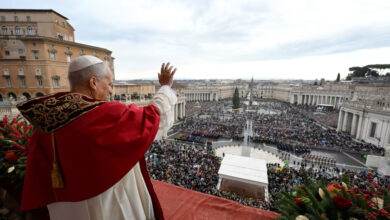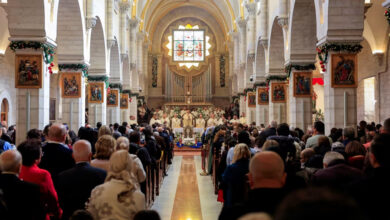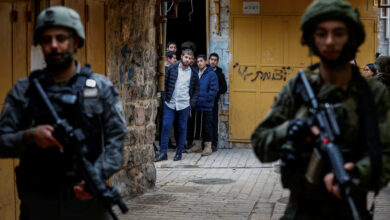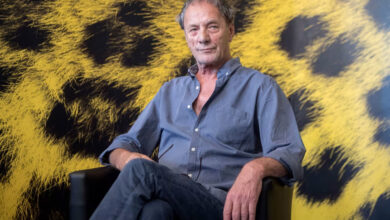
The Israeli military says “professional failures” led to the killing of 15 paramedics and first responders in an incident in Gaza in March, according to an investigation released Sunday.
The group – most of whom worked for the Palestine Red Crescent Society (PRCS) – were shot dead before being buried in a mass grave, sparking international condemnation.
The Israeli probe identified several failures during the incident, as well as breaches of orders and a failure to fully report the incident, the Israel Defense Forces (IDF) said in a statement. The military still stood by the decision-making of the soldiers who carried out the attack on the convoy, with the IDF’s top spokesman Brig. Gen. Effie Defrin saying the incident was based on “a chain of mistakes…but no ethical gaps.”
The IDF said the troops did not engage in “indiscriminate fire” during the incident, but they opened fire on what they believed to be a “tangible threat” amid what the military called an “operational misunderstanding.”
As a result of the investigation, the commanding officer of the 14th Brigade received a letter of reprimand, while the deputy commander of the Golani Reconnaissance Battalion involved in the incident was dismissed from his position. The IDF relieved the deputy commander, a major who both ordered his troops to open fire and fired on the convoy himself, because of his responsibility for the incident and for providing an “incomplete and inaccurate report” about what happened.
“The IDF regrets the harm caused to uninvolved civilians,” a statement read.
“Existing protocols have been clarified and reinforced – emphasizing the need for heightened caution when operating near rescue forces and medical personnel, even in high-intensity combat zones.”
But the general who oversaw the Israeli military’s investigation into the killings said he would not recommend any changes to the IDF’s combat policies or rules of engagement.
Maj. Gen. Yoav Har-Even said he believes the commander who ordered troops to open fire “acted reasonably” and in accordance with IDF rules of engagement. “There was no evidence of any unethical or immoral conduct by the forces,” Har-Even told CNN.
“It’s a mistake. It can happen tomorrow – I hope it will not happen – unfortunately it happened,” Har-Even said. “The orders are excellent. We don’t shoot on an ambulance unless they are clearly identified terrorists, or we understand that someone feels a threat from people that are coming from the ambulance.”
Har-Even’s comments came during a 90-minute briefing with international media, in which he described several of the commander’s actions as “mistakes,” but stopped short of acknowledging wrongdoing on the part of the commander or his forces. His findings have been sent to the Israeli military’s advocate general, who will determine whether to file any charges against the soldiers involved.
‘Operational errors’
The troops opened fire on three separate occasions on Sunday, March 23. In the first shooting, Israeli soldiers shot at a vehicle the IDF says was identified as belonging to Hamas. Two Palestinians were killed and one temporarily detained.
An hour later, the troops opened fire once again, this time targeting the convoy of PRCS ambulances and Civil Defense vehicles, killing another 12 Palestinians, according to the investigation.
Autopsy reports for the eight PRCS medics obtained by CNN show that most were killed by gunshot wounds to the head or chest, while others suffered from shrapnel to the torso from the force of an explosive injury. The bodies had started decomposing after they were buried in a mass grave for more than a week.
Initially, the IDF claimed the vehicles were driving suspiciously without headlights or emergency signals.
But video from the cell phone of one of the emergency responders clearly showed that the convoy was driving in a single-file line and the ambulances had their lights on. Despite the release of the video, the IDF investigation still said it was difficult to identify the ambulances.
“Due to poor night visibility, the deputy commander did not initially recognize the vehicles as ambulances,” the IDF said. “Only later, after approaching the vehicles and scanning them, was it discovered that these were indeed rescue teams.”
The IDF said that six of those killed were identified “in a retrospective examination as Hamas terrorists,” raising the question of whether the troops opened fire on ambulances before knowing if there were any militants amongst the vehicles. The military did not identify which of those killed it believed were terrorists or provide any evidence.
About 15 minutes later, the troops opened fire on a Palestinian United Nations vehicle, killing a fifteenth individual, an employee of the United Nations Relief and Works Agency for Palestine Refugees. The investigation concluded this was a result of “operational errors” and was “in breach of regulations.”
In video filmed by one of the military’s aerial surveillance assets, Israeli troops can be seen opening fire on the clearly-marked United Nations vehicle, minutes after they ended their attack on the convoy of emergency response vehicles.
In the video, which the military showed to reporters but declined to release, a UN vehicle can be seen arriving at the scene of the military’s deadly attack on the ambulances and a fire truck. As the UN vehicle attempted to drive slowly past the scene, individuals identified by the military as Israeli soldiers opened fire on the UN vehicle from behind as it was driving away.
“The examination determined that the fire in the first two incidents resulted from an operational misunderstanding by the troops, who believed they faced a tangible threat from enemy forces,” the IDF said. In its initial account of the events, the Israeli military said the two Palestinians killed in the first incident were members of Hamas. It’s unclear if Israel is now walking back that claim.
“The third incident involved a breach of orders during a combat setting,” the IDF said.
The bodies were then removed and buried in a mass grave along with the ambulances and other vehicles. The IDF defended the field commanders’ decision to remove the bodies but acknowledged “the decision to crush the vehicles was wrong.”
Har-Even said the attack on the convoy stemmed from a series of faulty assumptions that soldiers from the elite Golani Reconnaissance Battalion made that day and from the deputy battalion commander’s poor line of sight to the convoy, which he said was obstructed by a hillside.
Har-Even did not explain why troops continued to fire at the convoy of ambulances even as they got closer to the convoy and faced no return fire. He also said he did not believe the deputy commander had lied about the incident, even as he acknowledged he gave false statements about the flashing lights on the emergency vehicles and the subsequent attack on a UN vehicle minutes later.
“There was no attempt to conceal the event, which was discussed with international organizations and the UN, including coordination for the removal of bodies,” the IDF said.
Palestine Red Crescent decries ‘contradictions’ in Israeli probe
The president of the Palestine Red Crescent Society said “there are a lot of contradictions” in Israel’s accounts of the killing of the emergency workers.
“It is clear that in the same report and in their press conference – the occupying forces – there are a lot of contradictions,” Younis Al-Khatib said in an interview on Al-Araby TV on Sunday after Israel released its investigation.
Al-Khatib pointed to the cell phone video showing the convoy driving in a single-file line with the ambulances’ headlights on.
“Either you did not see the lights of the car and you didn’t realize these are ambulances. As you saw the video that came out, they lied and it was proven … How can you claim you didn’t see anything, you didn’t see the lights? All the evidence came out and proves that this story is untrue,” Al-Khatib said.
In the wake of the attack, the organization said the incident “can only be considered a war crime punishable under international humanitarian law, which the occupation continues to violate before the eyes of the entire world.”
CNN’s Mounira Elsamra contributed to this report.




